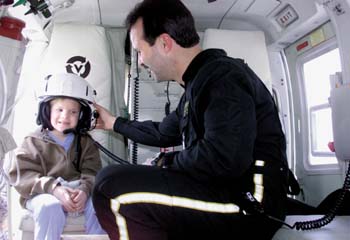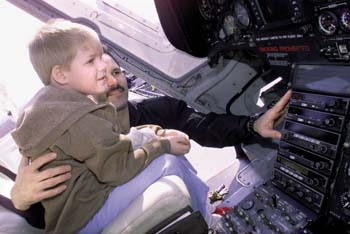
Trevor Moore tries on the radio helmet in a LifeFlight helicopter recently. Flight nurse Mark Tankersley was working when Trevor and his mother were injured in an accident in Mt. Pleasant. (photo by Dana Johnson)
LifeFlight’s Bedford County base saves time, lives

Trevor gets a peek in the cockpit of a LifeFlight helicopter with flight nurse Mark Tankersley, who recently helped save Trevor’s life. (photo by Dana Johnson)
After five full days of ark-inspiring rain, the sun rose in a fresh-scrubbed sky Saturday morning, Feb. 17, shimmering off standing water across rural middle Tennessee’s swollen creeks and flooded fields.
In a 7:30 a.m. briefing in the Bedford County LifeFlight crew headquarters, pilot Greg Stoddard declared a “green-green” day – the weather was clear for launching locally and flying cross-country. Flight nurses Sandy Jones and Mark Tankersley were ready to begin their shifts – Jones a 24-hour haul, Tankersley a 12-hour day.
But the weekend started darkly for two cars headed in opposite directions down a two-lane straightaway stretch of Maury County highway.
Just after 9 a.m., Crystal Moore was driving into Mt. Pleasant on Southport Road with her 5-year-old son Trevor strapped into the front seat. “I was going to pass a vehicle and was on top of a hill,” Crystal remembered. “There’s a blind spot in the road where you can’t see. I got over and was picking up speed and then saw the car and couldn’t get back over in time. I hit that car head-on.”
The bright spot for Moore that morning was the location of one of Vanderbilt University Medical Center’s two twin-engine American Eurocopters. Since Vanderbilt placed one of its two flying lifesavers at Bedford County Medical Center in Shelbyville, LifeFlight crews have shaved crucial minutes off the response time.
After a year of studying potential satellite locations, Bedford County was chosen for its close proximity to a hospital and local EMT station, according to Dr. John A. Morris Jr., professor of Surgery and director of Trauma. The helipad was already approved by the Tennessee Department of Transportation and contained space for a crew’s quarters.
In some far-reaching counties southeast of Vanderbilt, the “golden hour of trauma” – initiating stabilizing care within one hour of a trauma – has been reduced by 20 minutes.
“We can be from here (Shelbyville) to Tullahoma in seven minutes,” Tankersley said. From VUMC, it takes 28 minutes to reach that town in southern Coffee County.
“This is part of LifeFlight’s traditional outreach concept, taking Vanderbilt to the patient rather than the patient coming to Vanderbilt,” Morris said. “It lets us start Vanderbilt protocol in the field, as opposed to waiting for the patient to get to Vanderbilt.”
There’s no quantifiable data to show how much morbidity or mortality is decreased with each minute saved. But the LifeFlight helicopters always carry two liters of O-negative blood, and Morris said, “It doesn’t take a rocket scientist to realize, if you bleed a shorter period of time you bleed less.”
The logic is not lost on Moore. “I’m glad they have them (the LifeFlight helicopter and flight nurse crews) there,” she said. “I guess if they didn’t have them, there was a pretty good chance me and my son would have died, because we lost a lot of blood.”
The satellite helipad also expands Vanderbilt’s catchment area. It adds another 140-mile radius to the other VUMC-based aircraft and increases the total coverage area to 65,000 square miles, improving access to the Medical Center for the community, Morris said.
From Shelbyville, the number of flights is steadily increasing, nearing 40 flights per month, said Linda Passini, LifeFlight manager. Since operations there began July 24, LifeFlight has made more than 85 transfers. The program will get a better idea of long-term growth after the spring and summer season, when weather permits more flights and more traumas occur.
Also, Morris said, LifeFlight operations recently went from 16 hours a day to 24 hours a day, another factor that will add to the overall volume.
Shortly after Moore’s crash, the VUMC and Bedford County LifeFlights, known as LifeFlight 1 and LifeFlight 2 respectively, were placed on alert. There were potentially four transports. At 9:17 a.m., pilot Stoddard got a call from dispatch. “That’s us. We’re a go.” Twelve minutes later the crew lifted off the helipad and headed west. Less than 20 minutes later, Stoddard landed the helicopter and Jones and Tankersley jumped into action.
The “scene” was stretched over a quarter mile, as a dozen emergency vehicles – ambulances, fire trucks from volunteer outfits, state highway patrol cars and wreckers – blocked the highway.
Moore’s white Buick Century and a dark green Pontiac Bonneville, their front ends flattened, sat amid shattered glass, plastic and metal, opposing each other, perpendicular to the roadway. Deflated airbags drooped from the dashboards and steering wheels. From the Pontiac, whose extricated occupants were not identified for this story, a pile of baby clothes spilled from the back seat to the front – a lemon lollipop lay on the pavement outside the driver’s door. From the rearview mirror of Moore’s Buick, a picture frame spun in the wind behind a shattered windshield, the photo missing.
Trevor was badly injured as part of his skull was shattered. Trevor ‘s head was wrapped as the bandage turned to crimson. Tankersley loaded the boy into the chopper’s belly as Jones raced to Crystal. Soon, mother and son were side-by-side, laid out on the custom-designed stretchers in the back of the helicopter, with Jones and Tankersley working furiously to stabilize the patients.
As LifeFlight 2 lifted off, about five minutes after arriving, LifeFlight 1 began to touch down. At 10:28 a.m., LifeFlight 2 was atop VUMC ‘s new helipad, SkyPort. Trevor had been intubated, his mother was receiving IV medication and both were prepped for VUMC’s emergency department personnel.
Crystal Moore spent several days in the hospital. She’s at home now, recovering from broken bones in her pelvis, a collarbone and both legs. “I’ve got so much metal in me they tell me if I go to an airport I’ll set off the metal detector,” she said.
Trevor’s skull was patched; the boy has no long-term side effects from having his brain exposed. He’s still in Children’s Hospital, playing with an entourage of new Pokemon toys and stuffed animals while internal injuries heal.
Trevor’s grandfather, Hollis Moore, spends hours on end with his grandson. He was a first-responder, a volunteer emergency response member of Maury County’s Civil Defense for 20 years. His experience carries weight when he says, “When you’re in a predicament like that (Crystal and Trevor’s crash), every minute helps. Having LifeFlight in Shelbyville cuts down transfer time for surrounding counties. Five minutes is a long time when you’re hurt bad. LifeFlight, to me, is a life saver,” he said one day, his hand on his grandson’s scarred, but intact, blond head.













